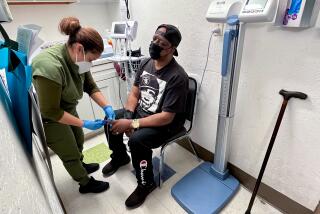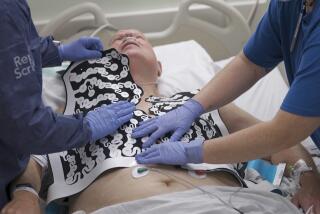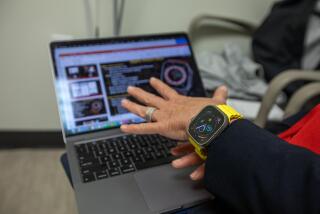Echocardiography: Telltale Images of the Heart : Non-Invasive Procedure Called an Accurate, Low-Risk Test for Deadly Disease
- Share via
The shape pulsating on the small video screen looks like some type of dangerous microbe, a movie shot through the lens of a microscope. Actually, it is far worse.
With computer-generated dotted lines showing the four-chambered image, the shape can be identified as a perilously expanded human heart. It is a heart, Dr. Gus Kunelis said, that will almost surely kill its owner.
It is also a heart that did not betray its potentially deadly nature on the tape of an electrocardiogram or during a conventional treadmill stress test.
But when the 45-year-old man was tested at St. Jude Hospital & Rehabilitation Center in Fullerton using the computer-enhanced screen image, the result “was so bad that we couldn’t even operate on him,” Kunelis said. “And that case isn’t one in a million. It’s frequent enough that it is frightening.”
The high-tech cardiac sleuth is called stress echocardiography, and it may help save many diseased hearts whose problems would have gone undetected, said Kunelis and Dr. Donald Mahony, who are associate director and director, respectively, of St. Jude’s Non-Invasive Lab.
The technique is called “non-invasive,” Mahony said, because it requires no injections or catheters.
Detects ‘Silent Killer’
The procedure is designed to detect coronary artery disease, particularly myocardial ischemia, the so-called “silent killer” artery blockage that often causes sudden death. Echocardiography is being hailed in many cardiology circles as safe, accurate, inexpensive and easy, and Mahony said physicians “are going through here like a revolving door” to learn how to administer the test. The St. Jude lab is the only medical facility in Orange County performing the stress echo test. It is also offered at Harbor-UCLA Medical Center in Torrance, UCLA Medical Center, Loma Linda Medical Center and Desert Hospital in Palm Springs.
The test uses ultrasound waves to form a video image of the heart. The waves echo from the heart’s surface to a sensing device that measures the volume of blood expelled after each contraction and the motion of the heart wall. The waves are produced by a transducer, which is placed at different angles to the heart outside the patient’s chest.
It’s called a stress test because the patient lies on his back and pedals a bicycle chain-wheel mechanism attached to the end of the table. The exercise elevates the heartbeat and allows comparisons between the heart under resting conditions and during physical exertion.
The patient also is monitored throughout the test by a blood pressure meter and a 12-lead electrocardiogram. But, Mahony said, “we can see all kinds of heart muscle defects on the echo even though the EKG is running along normally.”
Mahony said he uses the supine bicycling technique at St. Jude, rather than an upright bicycle or a treadmill, because it causes a greater flow of blood to the heart and is therefore more apt to signal an abnormality.
The image on the screen is videotaped and run through a computer, which traces the outline of the heart and its chambers with white dotted lines.
Stress echocardiography has seen limited use since the early 1970s, Mahony said, but the equipment was cruder and often couldn’t produce a decipherable picture. Today, however, the pictures show resolution on objects as small as a millimeter, he said.
He said a stress echo test costs about $500, about the same as a thallium scan, a series of X-rays of blood flow around the heart.
Perhaps the greatest advantage, however, is the capability of stress echocardiography to detect heart irregularities that display no warning signs or that may be missed during a resting electrocardiogram, treadmill test or thallium scan, Kunelis said.
A resting or treadmill electrocardiogram, he said, can only measure electrical impulses from the heart and therefore cannot accurately indicate such irregularities as abnormal heart wall motion or impaired blood flow. It is accurate 58% to 75% of the time in diagnosing coronary artery disease, Kunelis said. A thallium scan can also be fooled, he said. While thallium can pick up impaired blood flow in selected arteries, if all such arteries are about equally blocked the scan will appear normal, Kunelis said. It has an accuracy rate of 60% to 85%.
Echo Accuracy Rate
In 2 1/2 years, St. Jude doctors have performed about 800 stress echo tests, Mahony said, and subsequent testing to confirm the diagnosis has shown stress echo to be accurate 97% of the time.
Recently, Kunelis said, a 65-year-old man with no previous symptoms of heart disease was given a stress echocardiography test at St. Jude. He had passed a treadmill test and two thallium scans, Kunelis said. But the man’s doctor believed that there could be indications of heart disease and sent his patient to the Non-Invasive Lab.
“The resting part of his test was abnormal, but when we stressed him, it was horribly abnormal,” Kunelis said. “He had an angiogram done, and it showed severe triple valve disease.”
(The coronary angiogram is generally considered to be the definitive test for heart disease and is often used to confirm the results of other tests when bypass surgery is being considered. However, it costs about $2,000 and involves the use of radioactive dye and catheterization and can be fatal in 0.1% to 0.2% of cases, Mahony said.)
‘Biggie’ Has No Symptoms
The primary target at St. Jude is myocardial ischemia, Mahony said. It is nothing more than impaired blood flow to the heart muscle via the coronary arteries, but it shows no symptoms.
“It’s the biggie,” Mahony said. Finding it, he said, is “the basis of our whole program. For every three patients being treated for cardiac disease, there’s another one out there who doesn’t know what he’s got.”
Other Southern California cardiologists say they are becoming enthusiastic about stress echo.
“We’ve been using it here for about six years, and the ways in which the data can be analyzed are very accurate and the measurements are very precise,” said Dr. Leonard Ginzton, assistant professor of medicine and director of the non-invasive lab at Harbor-UCLA Medical Center in Torrance.
‘Beginning to Catch On’
“You immediately know whether an abnormality is present in a certain segment of the heart. It’s beginning to catch on. I think we’ll see widespread use of it within two years.”
At UCLA Medical Center in Los Angeles, where Dr. John Child directs a non-invasive laboratory, stress echo has been used on about 100 patients since the first test was given seven months ago. Child, an associate professor of medicine at the university, said he believes stress echo allows physicians to tell whether a patient will eventually need a procedure involving catheterization, such as a thallium scan or angiogram.
“If you see an abnormality during a stress echo test,” he said, “I think you still have to consider the possibility of catheterization,” although he said he believes stress echo is “as good as catheterization, and it’s cheaper than thallium.”
A particular advantage of the procedure, he said, is that it allows the physician to see the heart muscle at work. In cases where the heart muscle has been previously damaged, Child said the physician can, using stress echo, quickly tell whether the remaining heart muscle is functioning properly, thereby ruling out further invasive tests.
Differing Views
Dr. Julius Gardin, director of the cardiology non-invasive laboratory at UCI Medical Center in Orange, said: “I think it will give as good or better information than thallium. You can see if the heart muscle is thickening properly, and you can look for clots, which is tougher to do with thallium. With the equipment available now, you can do a pretty good job. It’s just at the point where it’s starting to catch on. It’ll take a little time to be accepted, but I think when the rewards become known, it’ll shake out pretty well.”
One Harvard Medical School professor, however, said he believes stress echocardiography won’t “catch on in a big way.”
“It’s hard to do,” said Dr. Charles Boucher, chief of nuclear cardiology at Massachusetts General Hospital in Boston. “Not everyone can be echoed” because of obesity, lung disease or chest deformities that may obscure the image of the heart.
Boucher said he believes that the proponents of stress echo have not tested a sufficiently broad mix of patients to justify their claims of success.
“Whenever a new technique has come to the fore,” he said, “the earliest patients have had obvious disease” and therefore were easiest to diagnose correctly. “We’re going to need a little more time before we can say it’s a superior test.”
Doctors Can Do Test
Still, he said, cardiologists are likely to gravitate to stress echo because they can do it themselves. A thallium scan must be done by a radiologist, unless the cardiologist has a license to use radioactive material, which he or she rarely does, Boucher said.
“Doctors tend to do their own tests if they can,” Boucher said, “and there may be a natural tendency on the part of cardiologists to turn to stress echo because of the ease of regulations.”






